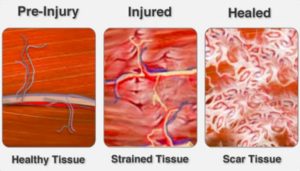Dealing With The Past – Part I: Physical Factors
After an injury, some people receive excellent care from their doctors and therapists and are told that they are fully "healed"...yet they still experience pain and difficulties with their activities. One of the reasons for this (and something that is commonly overlooked by healthcare providers) is the formation of scar tissue in the body.
The healed skin we see at the site of injury is just the tip of the iceberg. Beneath is a vast network of tissues that are stuck together because of improper healing - resulting in symptoms of stiffness, itchiness and pain. These adhesions and scar tissues can prevent the body from working properly and prevent proper recovery.

Figure 1 – Excess scar tissue can restrict normal movement of tissue and constrain nerves and blood vessels
Fortunately scar tissues can, to a certain extent, be remodeled. We have found manual therapies are quite effective in treating scar tissues and adhesions and we've seen people with very old scars (as old as 40 years) improve in pain, itching, stiffness, colour, temperature, etc. Moreover, clinicians can teach clients how to perform some therapies at home to speed up tissue remodeling.
